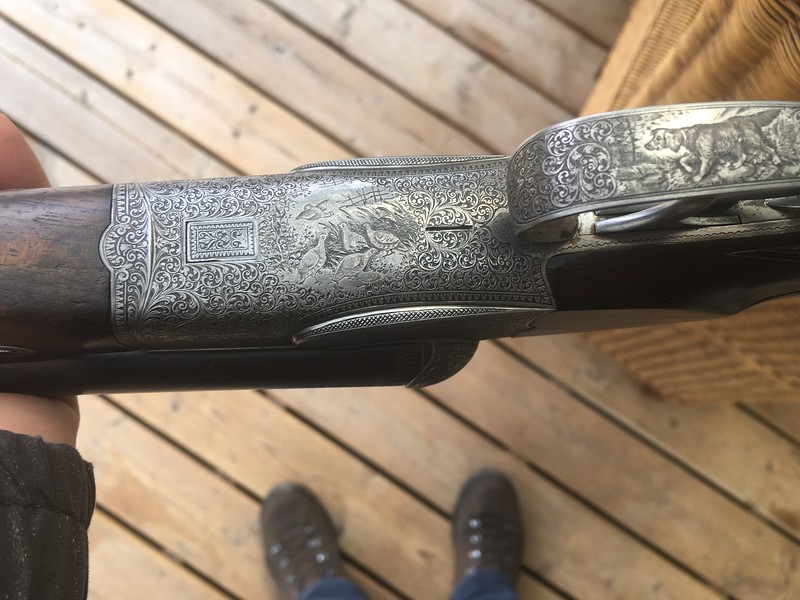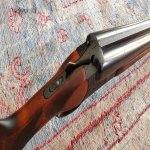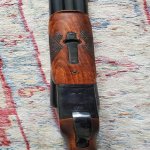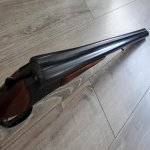I haven't posted in a while, so here goes.
In the early days of breech-loading guns, all actions were seriously weird. The idea of barrels that moved, of guns breaking open in the middle to load… Just weird.
The earliest methods to fix the barrels closed involved an interrupted screw, operated by a lever, and acting on lugs brazed to the barrels. Casimir Lefaucheux was the first to do this for his pinfire system. The first levers faced forward, under the action and fore-end. Such levers work well but have a certain awkwardness to them.
Beatus Beringer, one enterprising gunmaker of Paris and St Etienne, made the lever swing rearward and combined the lever with the trigger guard. Exactly when is not known to me, but probably in the 1840s if not earlier. What is wholly unclear is who later decided to leave the trigger guard alone and have a separate under-lever follow the contour of the trigger guard bow – the classic 'lever-over-guard' pattern. Beringer may have done this himself, or a British maker may have been inspired by a Beringer gun to do so. The evidence is far from clear. The first 'lever-over-guard' guns started appearing in Britain around 1859, possibly earlier in France.
The late 1850s is a curious time for breech-loaders in Britain. The invention was gaining popularity, but there were probably no more than one or two hundred examples in all of Britain. Only a handful of makers knew how to make one, and even if such makers could manage to make 20 in a year, they probably couldn't move half of them. At some point, the reverse would happen, where demand exceeded supply – something that would have occurred after 1860.
One option in the 1850s in Britain was to use French or other continental guns if a London gun couldn't be had or afforded. More acceptable would be to have a British gunmaker import and market such guns under their name.
As a result of some fortuitous events, the following gun dropped into my lap. It is a 16-bore pinfire game gun, signed Robert Marrison, with a Belgian copy of a typical Beringer action.
The Marrison gunmaking family started with Samuel Marrison, born in 1796 in Norwich, England. In 1821 he established his business in St Benedict's Street, and by 1843 the business had moved to 50 Great Orford Street. In the 1851 census records, Samuel described himself as a gunmaker employing one man and one boy. Samuel had three sons, Samuel Ray, Robert, and Benjamin. Around 1855 Samuel died, and his son Robert continued the business in his name. The 1861 census records Robert as a gunmaker and ornamental engraver. In 1863 Robert Marrison obtained a patent for a forward sliding and side opening breech action, so he was a capable inventor, too. Sometime around 1891, Robert retired, and the Orford Street business closed in the 1890s.
The press of the day records a much more entertaining history. In 1855, Samuel's widow published an advertisement recommending her sons Samuel and Robert
"as being fully qualified to carry on the business" and that the firm would continue under the name
'Robert Marrison.' I wonder what the elder Samuel thought of being passed over. However, in July 1858, Marrison was bankrupt. His entire stock was sold off at less than cost price, including
"very superior Breech Loading Double Guns, made upon the newest and most approved principles." The business continued, but in late 1860 Marrison suffered another setback when his shop blew up, possibly from a gas leak, an error concerning a large quantity of black powder, or both. Tragically a young man was killed, and walls and part of the street were demolished. The local press had a field day. Marrison went bankrupt again in 1867, and in 1870 was before the courts for selling fireworks without a license. In 1873 he had to take out advertisements in defence of slander from one of his brothers. But the most bizarre turn was in 1891 when Robert Marrison was convicted for fraud, involving several lurid bait-and-switch schemes about hunting dogs and guns, using advertisements in the shooting press. Quite the history, all in all.
But let's go back to this most interesting gun. In outward appearance, it looks like a typical Beringer gun, with a short wooden fore-end and a rearward under-lever that doubles as the trigger guard. By the 1850s, the Beringer patent appears to have run out. This particular action was made by
'M. Godin,' presumably Jean Louis Mathieu Godin, of Herstal, Belgium. The action bar is marked
"M. Godin 1865" and
"brevete 603", which I presume to be patent no. 1865, and patent use no. 603. I have tracked down photos of a few examples of Godin-marked guns, all of which have the
"M. Godin 1865" patent stamp. I do not know what the patent refers to, as guns with this mark are found with Beringer-type underlevers and 'lever-over-guard' actions. The gun has a grip-safety variation, where a small stud behind the triggers has to be depressed by the returned underlever before the triggers can be pulled – clever! I thought the patent might have been for this variation, but other guns with the mark don't appear to have grip safeties.
The top rib is signed
"R. Marrison, Great Orford Street, Norwich, No. 2281," though no records have survived against which the serial number could be compared. The 29 11/15" damascus barrels have a Liège provisional proof and bore size in mm (17.2), but no Perron mark. There is an unknown barrel maker's mark, a crown over 'HV.' The barrels have London proof marks and bore size (15), and a London view mark on the action bar.
The fore-end is permanently attached, and the wood is unchequered. Sadly, like all early doubles with fixed fore-ends, the delicate edging to the sides has been damaged by attempts to pry off the fore-end by ham-fisted oafs unfamiliar with the design. The Lefaucheux-style double-bite barrel locking mechanism is of typical form. The combined rearward under-lever and trigger guard bow is identical to Beringer guns, locking in place with a stud on the rear end of the grip finial. The back-action locks are of Belgian shape, inset to the scalloped action back, and are signed
"R. Marrison." The bores are moderately pitted, and the gun weighs 6lb 10oz.
Dating this gun is a challenge. It would have to be 1855 or soon after, but I can't imagine the demand for such a gun would have been high once more typically British guns were available. The fact that so few of these guns appear to have survived supports the theory of their limited appeal to the British shooting public.


































































































